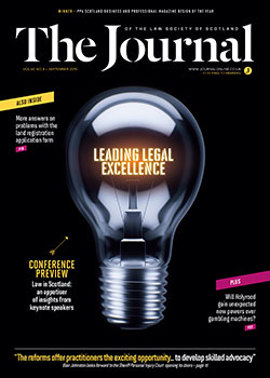Pensions: a formula unravelled

Very often, when a married couple separate, one of the most valuable matrimonial assets is a pension. The appropriate value attributed to a pension for separation/divorce purposes is the “cash equivalent transfer value” (CETV) at the relevant date, which is generally the date of separation.
The CETV often requires to be apportioned, as it is only the proportion of the rights referable to the period of the marriage which is in the matrimonial pot for division (s 10(5) of the Family Law (Scotland) Act 1985). Regulation 4 of the Divorce (Pensions) (Scotland) Regulations 2000 (SSI 112/2000) provides the relevant apportionment formula, namely:
A x B/C – where A is the CETV as at the relevant date; C is the period of the membership of a party in the pension arrangements before the relevant date; and B is the period of C which falls within the period of the parties’ marriage before the relevant date and, if there is no such period, the amount shall be zero.
Whilst the formula seems straightforward, the regulations fail to define the meaning of “period of the membership”, and consequently, for many years, the phrase has caused much debate amongst family lawyers. There were different schools of thought as to the meaning of the term, and in many cases the different interpretations resulted in vastly different values being attributed to pension rights for matrimonial asset purposes.
An extreme example
The issue was brought before the sheriff court in 2013 in the case of McDonald v McDonald. In this case, the husband joined a pension scheme in December 1978. The parties married in March 1985, and in August of the same year the husband retired from active service and ceased contributing towards his pension. He therefore only contributed towards his pension for five months during the marriage.
It was submitted on behalf of the husband that, when apportioning his pension, the period of his membership in the pension scheme should only be the period of active membership, i.e. five months. Such an interpretation would result in £10,002 of his pension being matrimonial property. However, it was submitted for the wife that “membership” covered all forms of membership (i.e. active, deferred and pensioner), so that the whole period of the marriage before the relevant date had to be taken into account. This interpretation would result in a matrimonial property valuation for the pension of £138,734, giving a difference in excess of £128,000 between the husband’s and wife’s valuations.
At first instance, the sheriff preferred the interpretation advanced on behalf of the husband. The sheriff considered that if the wife’s interpretation was accepted, then “B” in the apportionment formula could never be zero, despite the definition of B anticipating such a possibility. Furthermore, restricting “the period of the membership” to active membership would be consistent with the general principles of the 1985 Act, as that was the part of the pension which derived from the income or efforts of the party during the marriage.
Inner House division
The wife appealed the decision to the Court of Session, whose decision was delivered on 11 August: [2015] CSIH 61. The judges in the Inner House differed as to the interpretation of the term “period of the membership”, with Lady Smith dissenting.
Lord Malcolm, with whom Sheriff Principal Abercrombie QC agreed, upheld the sheriff’s decision. Against the background that s 10(4) of the 1985 Act provides that matrimonial property is property acquired during the marriage, Lord Malcolm commented: “Once payments into a pension cease, and the member becomes a deferred or pensioner member, I find it difficult to talk of the value of the pension as still being acquired… As it is, I prefer a purposive construction which avoids results going against the grain of the Act and the underlying legislative purpose.”
He recognised the possibility of the formula in reg 4 creating unfair outcomes, but he felt that s 10(6) of the Act was a “safety valve” since it allows for unequal division of matrimonial property if justified by special circumstances.
Lady Smith, dissenting, looked at the intention of the legislature, commenting that the regulations disclose no express intention to restrict their application to only one form of pension membership. Furthermore, she highlighted that had it been the intention to restrict applicability to “active membership”, then surely the legislature would simply have inserted the word “active” before “membership” in the formula.
Referring to s 10(4) and (5), Lady Smith pointed out that, if a spouse has pension rights or interests referable to the period during the marriage but before the relevant date, then such proportion as is so referable is to be taken to form part of the matrimonial property. Accordingly, she was of the view that there is no need to ask whether or not pension rights or interests were “acquired” during the marriage. Contrary to her colleagues, Lady Smith opined that acquisition was not a prerequisite to the value of pension interests being taken to be matrimonial property under s 10(5).
In Lady Smith’s view, the sheriff had failed to take several matters into regard: the nature of the pension valuation as a means of placing a capital value on a future income stream; that part of the value which reflected the wife’s continuing contingent interest in the scheme as surviving spouse; and the extent of judicial discretion in deciding what, in a particular case, amounts to fair sharing of the matrimonial property having regard to the principles of s 9 of the 1985 Act and the parties’ resources.
Comment
The decision in this case removes the uncertainty that has existed for so long over the treatment of pension rights that have been acquired through anything other than active membership of a pension scheme. It is now accepted that the phrase “period of the membership” in the regulations should be construed as the period of active membership, thereby precluding the period that someone is a deferred member or a pensioner member. This is in line with the spirit of the 1985 Act, namely that the division of the matrimonial property should be reflective of the fruits of the efforts of the parties during the marriage.
Going forward, disagreements regarding the interpretation of those four words should be avoided, which can only be a good thing for clients as disagreements inevitably lead to increased legal costs. Whether this matter will be considered further by the Supreme Court remains to be seen.
In this issue
- Good health – fair question?
- Time to raise the age of criminal responsibility
- Adoption of foreign children – a clash of cultures?
- Presumed liability: the case for action
- Le Bief Bovet: 700 years of litigation
- Reading for pleasure
- Opinion: James O'Reilly (fuller version)
- Opinion: James O'Reilly
- Book reviews
- Profile
- President's column
- Land Register completion update
- People on the move
- Conference calls
- A new court rises
- Questions of form
- Charities - why reserves matter
- Place your bets
- Pensions: a formula unravelled
- Whereabouts unknown?
- Lego Man keeps his mark
- The company one keeps
- Scottish Solicitors Discipline Tribunal
- Land, leases and LBTT
- Big budget brief
- Support sought as Napier joins the law clinics
- Public Guardian's fees to increase
- Law reform roundup
- TCPD: the Update way
- How are we doing?
- Thanks, but no thanks
- Ask Ash






